Connectedness Between Green Financial and Cryptocurrency Markets: A Multivariate Analysis Using TVP-VAR Model and Wavelet-Based VaR Analysis
Abstract
1. Introduction
2. Literature Review
3. Methodology and Data
3.1. TVP-VAR Connectedness Method
3.2. Wavelet Coherence
3.3. Data
| Cryptocurrencies | Sustainable Financial Indices | ||
| 1 | Binance | Dow Jones Sustainability World Developed Index | CCI30 Index |
| 2 | Ethereum | Dow Jones Sustainability Emerging Markets Index | |
| 3 | Litecoin | NASDAQ OMX Wind Index | |
| 4 | XRP | NASDAQ OMX Solar Index |
4. Empirical Results
4.1. Preliminary Analysis
4.2. Dynamic Total and Directional Connectedness
5. Conclusions
Author Contributions
Funding
Institutional Review Board Statement
Informed Consent Statement
Data Availability Statement
Conflicts of Interest
References
- Ali, S., Naveed, M., Yousaf, I., & Khattak, M. S. (2024). From cryptos to consciousness: Dynamics of return and volatility spillover between green cryptocurrencies and G7 markets. Finance Research Letters, 60, 104899. [Google Scholar] [CrossRef]
- Antonakakis, N., Chatziantoniou, I., & Gabauer, D. (2020). Refined measures of dynamic connectedness based on time-varying parameter vector autoregressions. Journal of Risk and Financial Management, 13(4), 84. [Google Scholar] [CrossRef]
- Baur, D. G., & Hoang, L. T. (2021). A crypto safe haven against Bitcoin. Finance Research Letters, 38, 101431. [Google Scholar] [CrossRef]
- Ben Ameur, H., Ftiti, Z., Louhichi, W., & Yousfi, M. (2024). Do green investments improve portfolio diversification? Evidence from mean conditional value-at-risk optimization. International Review of Financial Analysis, 94(1), 103255. [Google Scholar] [CrossRef]
- Bohte, R., & Rossini, L. (2019). Comparing the forecasting of cryptocurrencies by Bayesian time-varying volatility models. Journal of Risk and Financial Management, 12(3), 150. [Google Scholar] [CrossRef]
- Bouri, E., Lucey, B., & Roubaud, D. (2020). Cryptocurrencies and the downside risk in equity investments. Finance Research Letters, 33, 101211. [Google Scholar] [CrossRef]
- Caferra, R., & Vidal-Tomás, D. (2021). Who was raised from the abyss? A comparison between cryptocurrency and stock market dynamics during the COVID-19 pandemic. Finance Research Letters, 43, 101954. [Google Scholar] [CrossRef]
- Cepni, O., Demirer, R., & Rognone, L. (2022). Hedging climate risks with green assets. Economics Letters, 212, 110312. [Google Scholar] [CrossRef]
- Chopra, M., & Mehta, C. (2023). Going green: Do green bonds act as a hedge and haven for stock sector risk? Finance Research Letters, 51, 103357. [Google Scholar] [CrossRef]
- Conlon, T., & McGee, R. (2020). Safe haven or risky hazard? Bitcoin during the COVID-19 bear market. Finance Research Letters, 35, 101607. [Google Scholar] [CrossRef]
- Corbet, S., Hou, Y. (Greg), Hu, Y., & Oxley, L. (2021). Volatility spillovers during market supply shocks: The case of negative oil prices. Resources Policy, 74, 102357. [Google Scholar] [CrossRef]
- De Villiers, C., Kuruppu, S., & Dissanayake, D. (2021). A (new) role for business—Promoting the United Nations’ Sustainable Development Goals through the internet-of-things and blockchain technology. Journal of Business Research, 131, 598–609. [Google Scholar] [CrossRef]
- Duan, K., Huang, Y., & Mishra, T. (2023). Is Bitcoin more than a diversifier? A pre-and post-COVID-19 analysis. Finance Research Letters, 43, 102016. [Google Scholar] [CrossRef]
- Dutta, P., Choi, T.-M., Somani, S., & Butala, R. (2020). Blockchain technology in supply chain operations: Applications, challenges, and research opportunities. Transportation Research Part E: Logistics and Transportation Review, 142, 102067. [Google Scholar] [CrossRef]
- Elsayed, A. H., Gozgor, G., & Yarovaya, L. (2022). Volatility and return connectedness of cryptocurrency, gold, and uncertainty: Evidence from the cryptocurrency uncertainty indices. Finance Research Letters, 47, 102732. [Google Scholar] [CrossRef]
- Esparcia, C., Escribano, A., & Jareño, F. (2024). Assessing the crypto market stability after the FTX collapse: A study of high-frequency volatility and connectedness. International Review of Financial Analysis, 94, 103287. [Google Scholar] [CrossRef]
- Gallersdörfer, U., Klaassen, L., & Stoll, C. (2020). Energy consumption of cryptocurrencies beyond bitcoin. Joule, 4, 1843–1846. [Google Scholar] [CrossRef]
- Huang, J., Cao, Y., & Zhong, P. (2022). Searching for a haven from crude oil: Green bond or precious metals? Finance Research Letters, 50, 103303. [Google Scholar] [CrossRef]
- Klein, T., Pham Thu, H., & Walther, T. (2018). Bitcoin is not the new gold—A comparison of volatility, correlation, and portfolio performance. International Review of Financial Analysis, 59, 105–116. [Google Scholar] [CrossRef]
- Lee, C., Chow, Y., & McIntyre, J. (2021). Litecoin’s technological evolution and efficiency improvements. Journal of Digital Assets and Blockchain Technology, 4(2), 45–59. [Google Scholar]
- Li, Z., Xu, Y., & Du, Z. (2025). Valuing financial data: The case of analyst forecasts. Finance Research Letters, 75, 106847. [Google Scholar] [CrossRef]
- Mensi, W., Shafiullah, M., Vo, X. V., & Kang, S. H. (2022). Spillovers and connectedness between green bond and stock markets in bearish and bullish market scenarios. Finance Research Letters, 49, 103120. [Google Scholar] [CrossRef]
- Mensi, W., Vo, X. V., Ko, H. U., & Kang, S. H. (2023). Frequency spillovers between green bonds, global factors, and the stock market before and during the COVID-19 crisis. Economic Analysis and Policy, 77, 558–580. [Google Scholar] [CrossRef] [PubMed]
- Özkan, O., Meo, M. S., & Younus, M. (2024). Unearthing the hedge and safe-haven potential of green investment funds for energy commodities. Energy Economics, 138, 107814. [Google Scholar] [CrossRef]
- Patel, R., Gubareva, M., & Chishti, M. Z. (2024). Assessing the connectedness between the cryptocurrency environment attention index and green cryptos, energy cryptos, and green financial assets. Research in International Business and Finance, 70, 102339. [Google Scholar] [CrossRef]
- Patel, R., Kumar, S., Bouri, E., & Iqbal, N. (2023). Spillovers between green and dirty cryptocurrencies and socially responsible investments around the war in Ukraine. International Review of Economics & Finance, 87, 143–162. [Google Scholar] [CrossRef]
- Pourkermani, K. (2024). VaR calculation by binary response models. Data Science in Finance and Economics, 4(3), 350–361. [Google Scholar] [CrossRef]
- Ren, B., & Lucey, B. (2022). A clean, green haven? Examining the relationship between clean energy, clean and dirty cryptocurrencies. Energy Economics, 109, 105951. [Google Scholar] [CrossRef]
- Sedlmeir, J., Buhl, H. U., Fridgen, G., & Keller, R. (2020). The energy consumption of blockchain technology: Beyond myth. Business & Information Systems Engineering, 62(6), 599–608. [Google Scholar] [CrossRef]
- Smales, L. A. (2019). Bitcoin as a haven: Is it even worth considering? Finance Research Letters, 30, 385–393. [Google Scholar] [CrossRef]
- Torrence, C., & Compo, G. P. (1998). A practical guide to Wavelet analysis. Bulletin of the American Meteorological Society, 79, 61–78. [Google Scholar] [CrossRef]
- Torrence, C., & Webster, P. J. (1999). Interdecadal changes in the ENSO-monsoon System. Journal of Climate, 12, 2679–2690. [Google Scholar] [CrossRef]
- Truby, J. (2018). Decarbonizing Bitcoin: Law and policy choices for reducing the energy consumption of Blockchain technologies and digital currencies. Energy Research & Social Science, 44, 399–410. [Google Scholar] [CrossRef]
- Umar, Z., Mokni, K., Manel, Y., & Gubareva, M. (2024). Dynamic spillover between oil price shocks and technology stock indices: A country-level analysis. Research in International Business and Finance, 69, 102231. [Google Scholar] [CrossRef]
- Urquhart, A., & Zhang, H. (2019). Is Bitcoin a hedge or haven for currencies? An intraday analysis. International Review of Financial Analysis, 63, 49–57. [Google Scholar] [CrossRef]
- Wu, R., & Qin, Z. (2024). Asymmetric volatility spillovers among new energy, ESG, green bond, and carbon markets. Energy, 292, 130504. [Google Scholar] [CrossRef]
- Yousaf, I., Arfaoui, N., & Gubareva, M. (2024). Spillovers and hedging effectiveness between oil and US equity sectors: Evidence from the COVID-19 pre- and post-vaccination phases. Research in International Business and Finance, 69, 102204. [Google Scholar] [CrossRef]
- Yousaf, I., Nekhili, R., & Gubareva, M. (2021). Linkages between DeFi assets and conventional currencies: Evidence from the COVID-19 pandemic. International Review of Financial Analysis, 81, 102082. [Google Scholar] [CrossRef]
- Zeng, H., Huang, Q., Abedin, M. Z., Ahmed, A. D., & Lucey, B. (2025). Connectedness and frequency connection among green bond, cryptocurrency, and green energy-related metals around the COVID-19 outbreak. Research in International Business and Finance, 73, 102547. [Google Scholar] [CrossRef]
- Zhang, M., Zhang, C., Li, F., & Liu, Z. (2022). Green finance as an institutional mechanism to direct the belt and road initiative towards sustainability: The case of China. Sustainability, 14(10), 6164. [Google Scholar] [CrossRef]
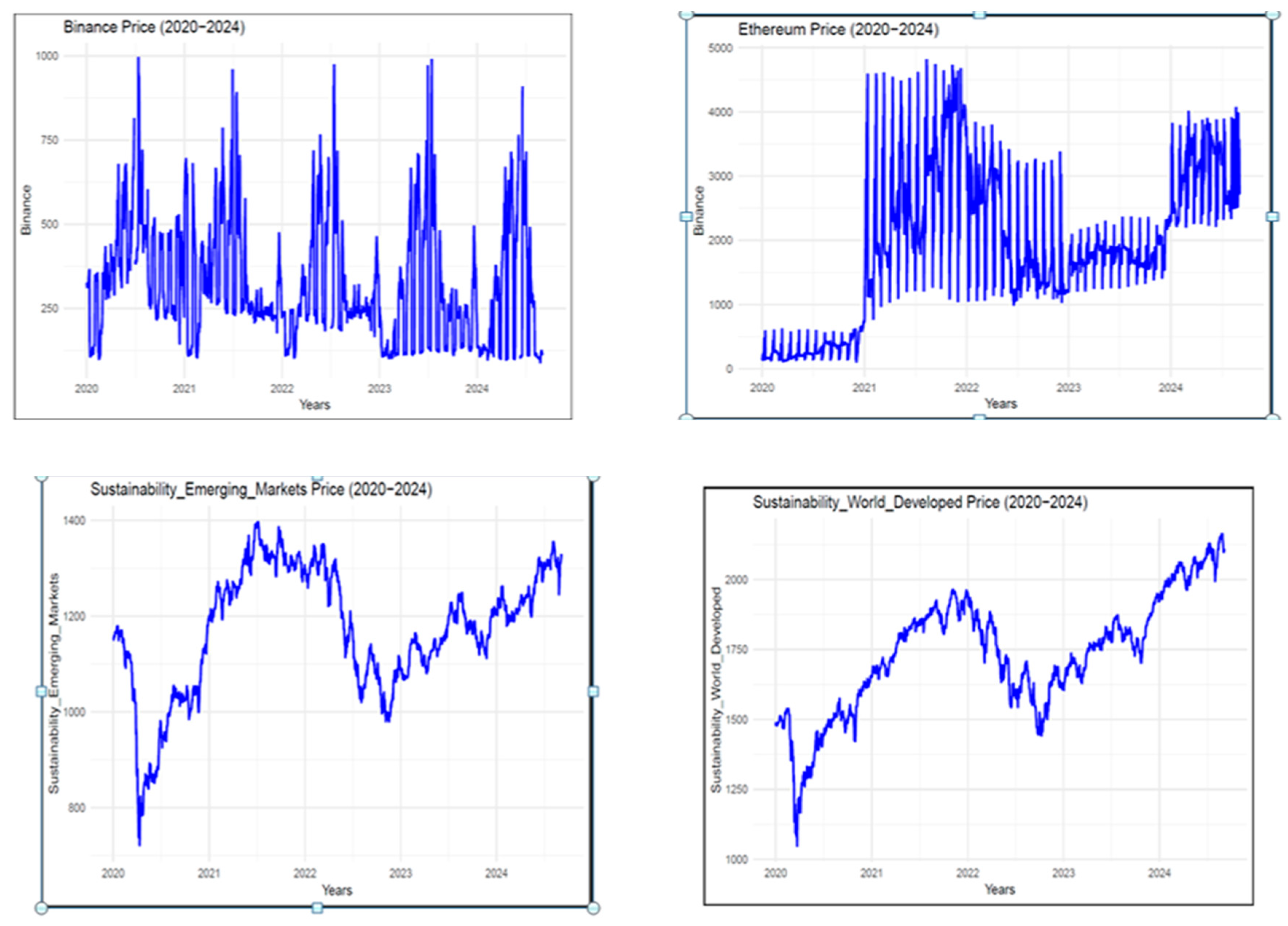



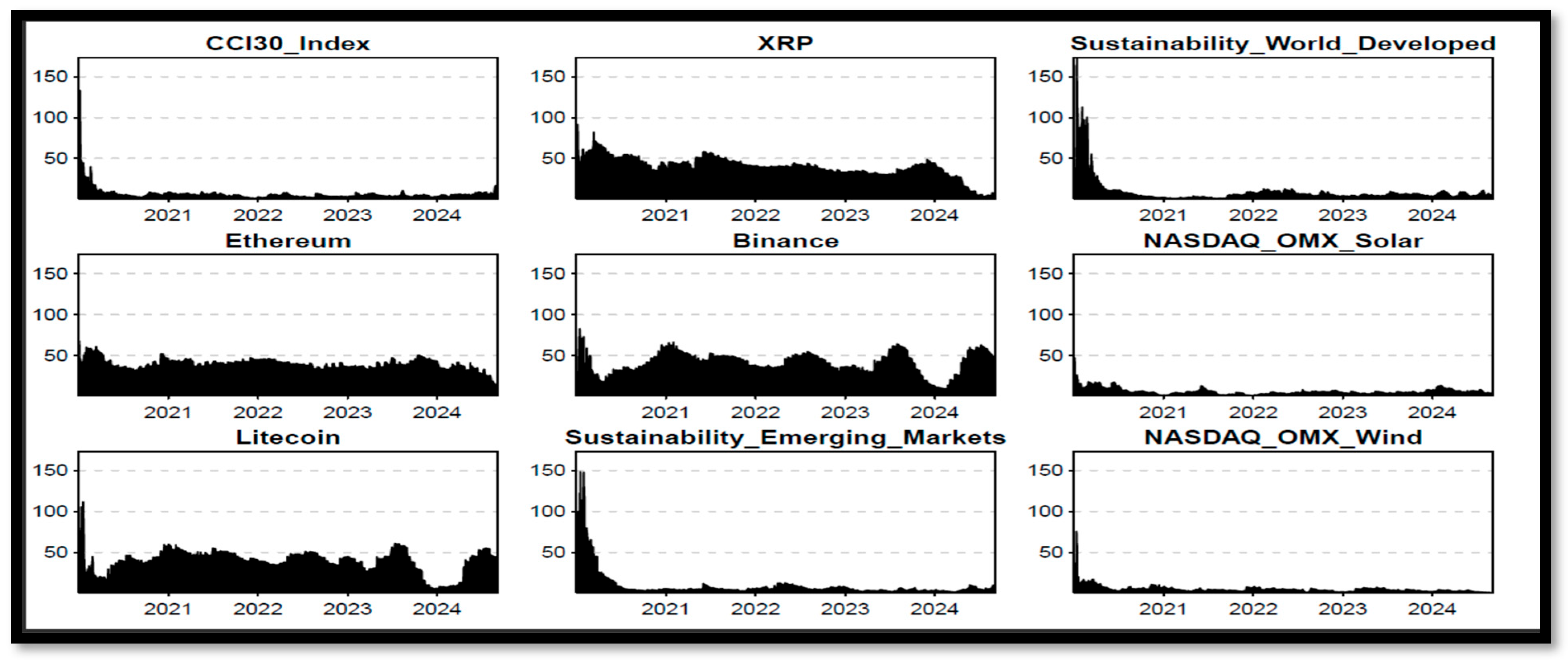

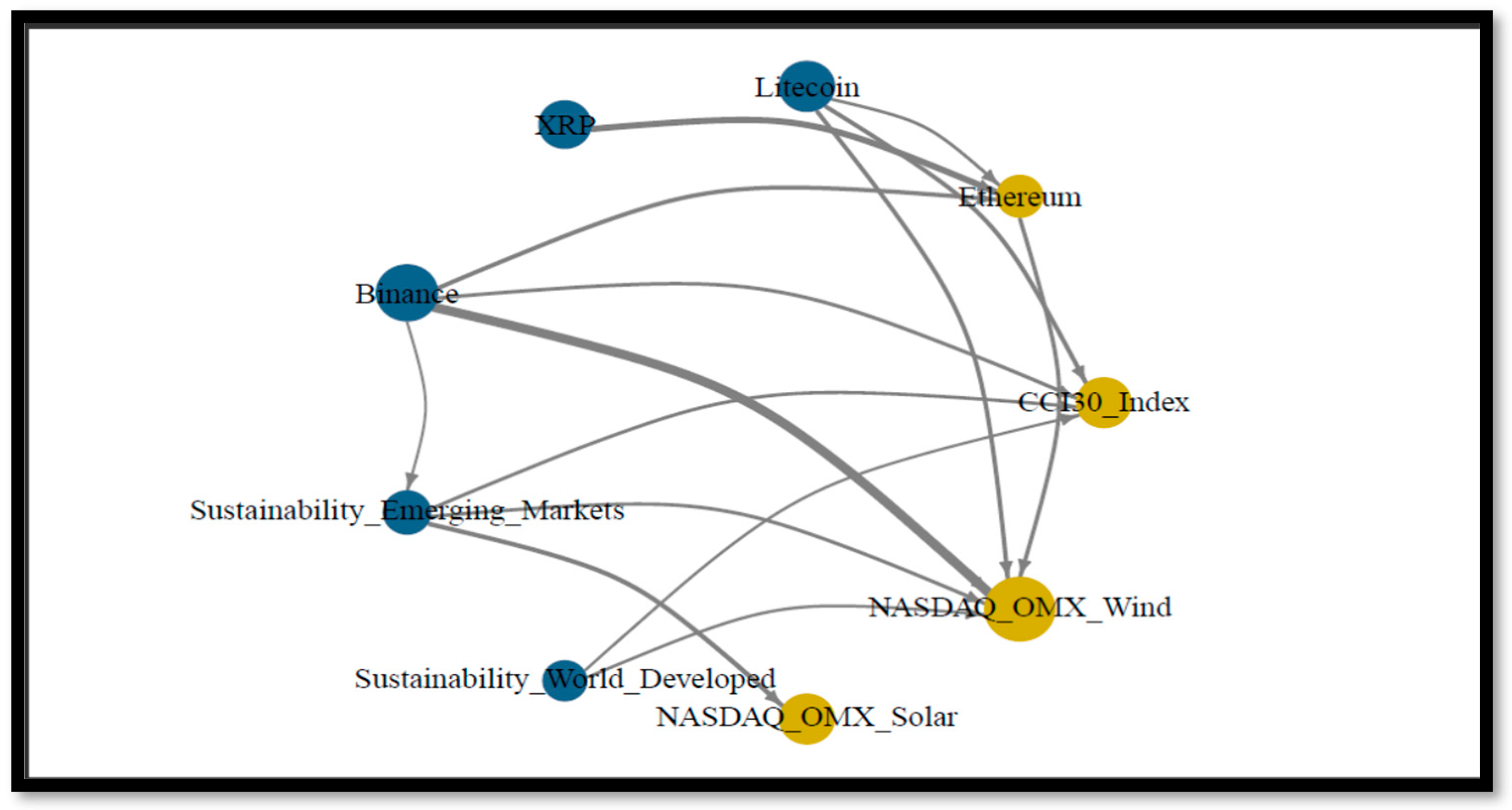
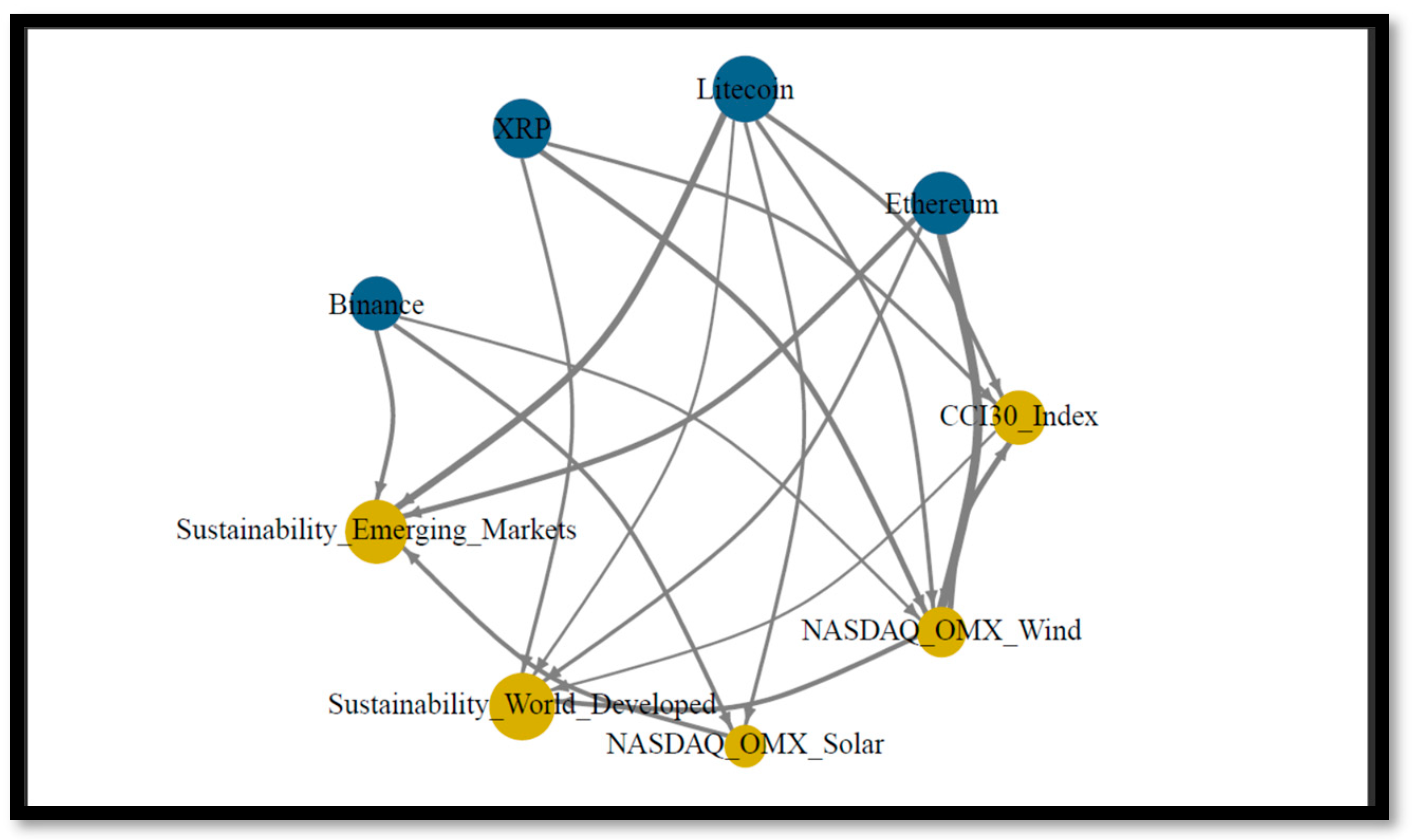
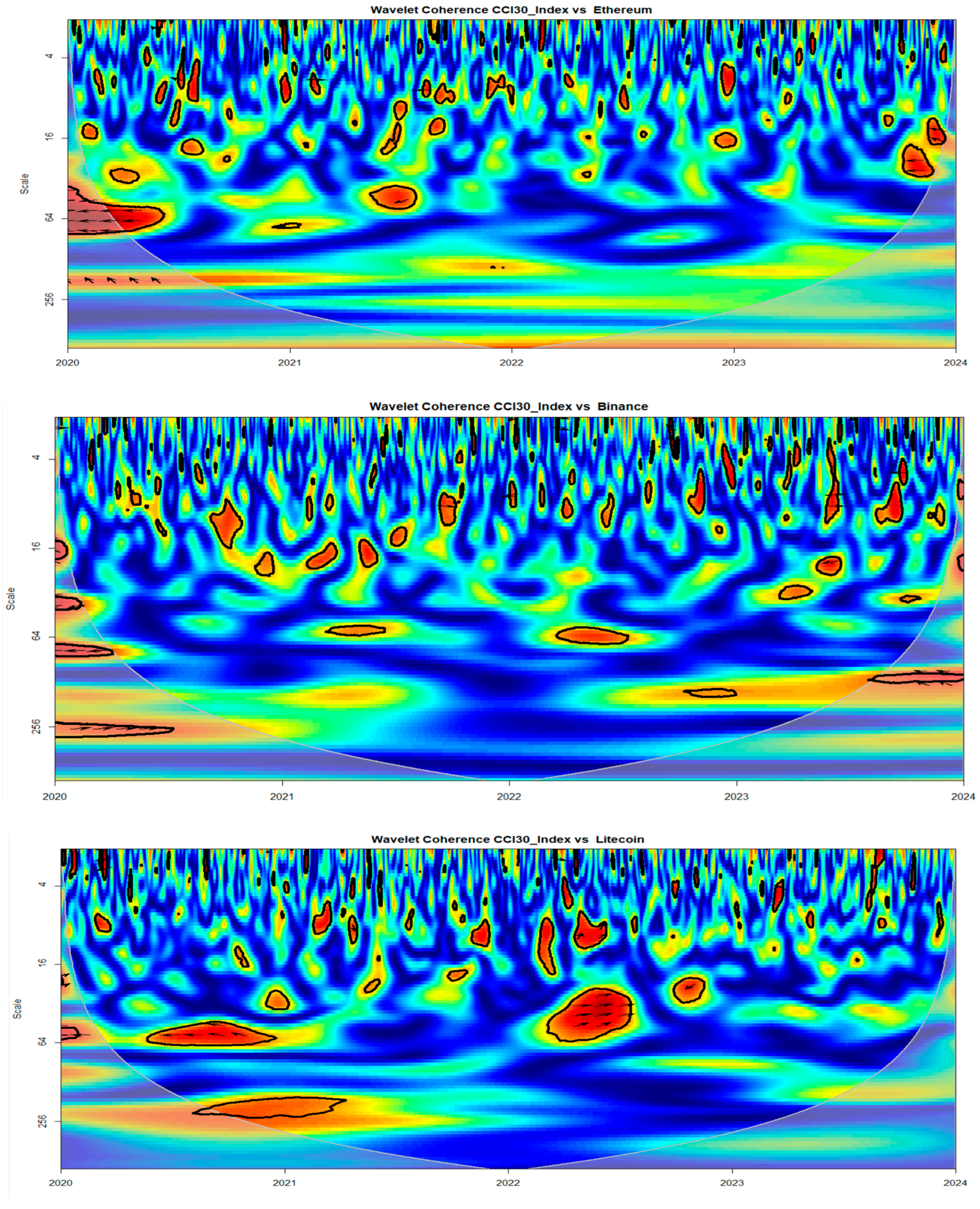
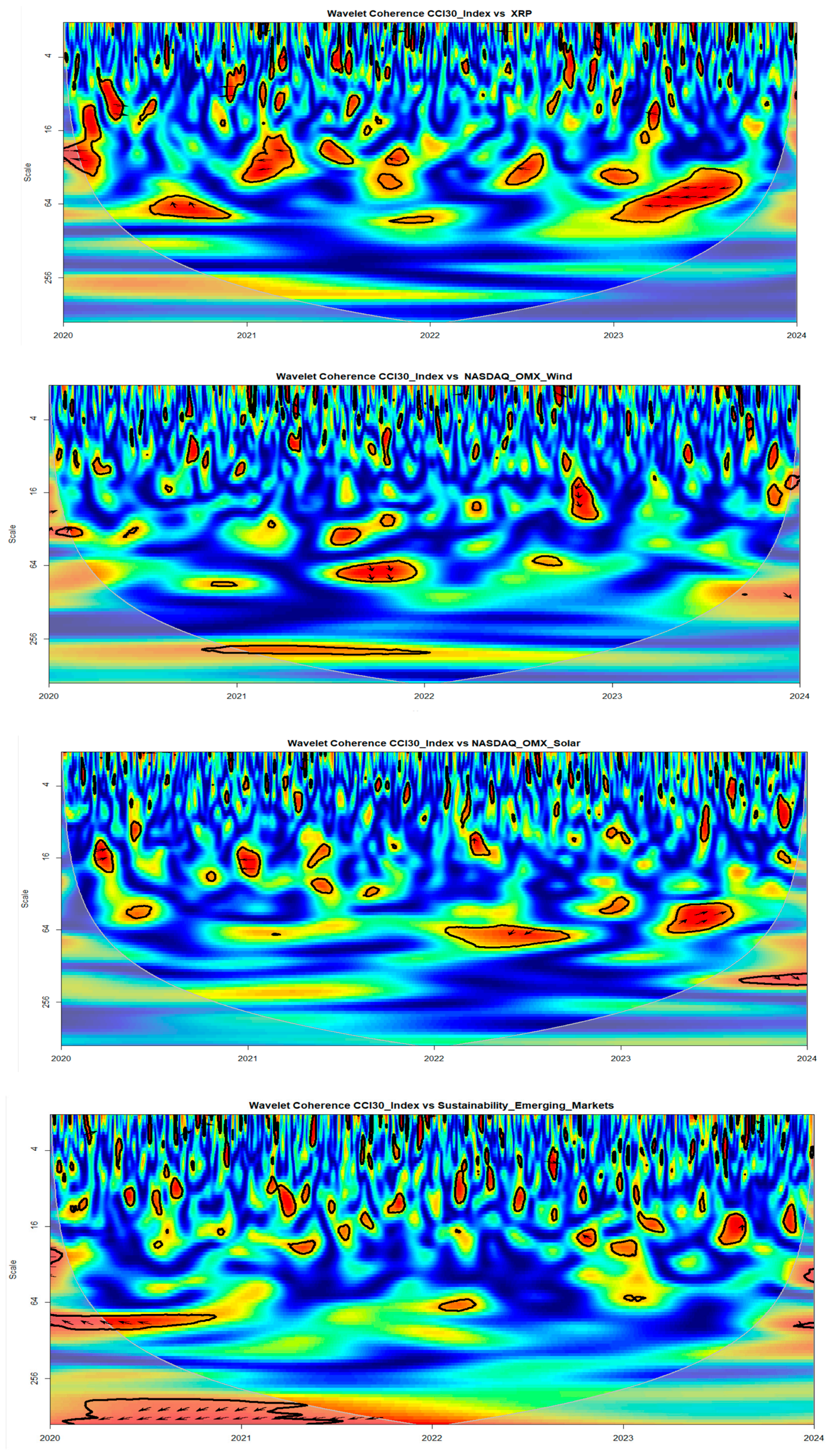
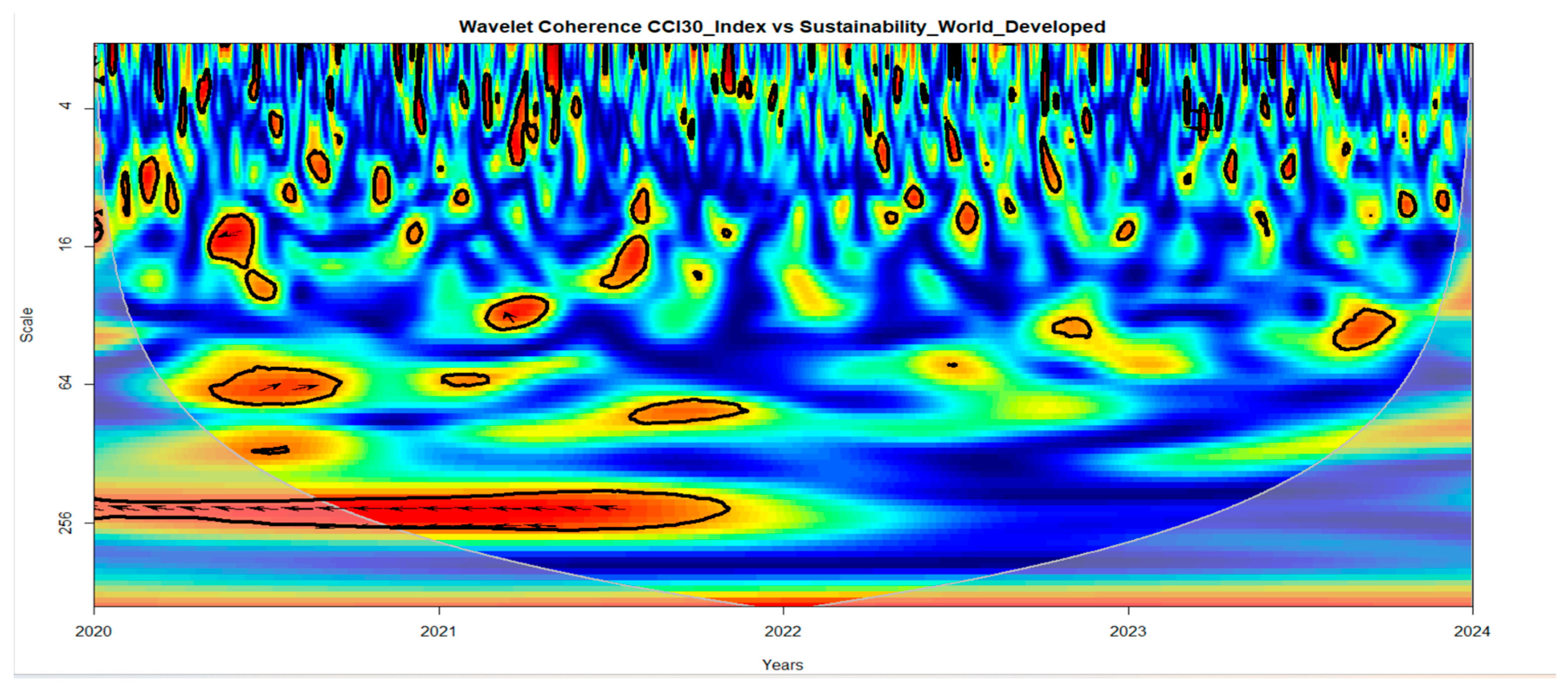
| Mean | SD | Skewness | Kurtosis | Jarque-Bera | PP | |
|---|---|---|---|---|---|---|
| Binance | −0.0237 | 0.2560 | 0.1250 | −1.2299 | 2499.9 | |
| Ethereum | 0.0017 | 0.2212 | 0.0032 | −1.2001 | 49.486 | |
| Litecoin | −0.0001 | 0.2011 | −0.0123 | −1.1961 | 1563.8 | |
| XRP | 0.0006 | 0.2373 | 0.0314 | −1.1573 | 775.86 | |
| CCI30 Index | 9.8653 × 10−5 | 0.0413 | 0.0020 | −1.2016 | 2678 | |
| Sustainability World Developed | 0.0002 | 0.0090 | −0.0079 | −1.1989 | 38.053 | |
| Sustainability Emerging Markets | 8.4872 × 10−5 | 0.0088 | 0.0085 | −1.2013 | 137.28 | |
| NASDAQ OMX Wind | −4.0162 × 10−5 | 0.0803 | 0.0148 | −1.2000 | 280.7 | |
| NASDAQ OMX Solar | 0.0007 | 0.0214 | −0.0199 | −1.1989 | 264.4 |
| CCI30Index | Ethereum | Litecoin | XRP | Binance | Sustainability Emerging Markets | Sustainability Emerging Developed | NASDAQ OMX Solar | NASDAQ OMX Wind | FROM | |
|---|---|---|---|---|---|---|---|---|---|---|
| CCI30_Index | 91.04 | 0.79 | 1.25 | 0.73 | 1.11 | 1.50 | 1.15 | 1.29 | 1.15 | 8.96 |
| Ethereum | 0.64 | 59.21 | 2.36 | 31.27 | 3.48 | 0.84 | 1.28 | 0.59 | 0.32 | 40.79 |
| Litecoin | 9.46 | 1.79 | 63.71 | 1.87 | 29.03 | 0.91 | 1.26 | 0.49 | 0.49 | 36.29 |
| XRP | 0.50 | 30.06 | 1.87 | 62.62 | 2.01 | 0.99 | 0.91 | 0.56 | 0.48 | 37.38 |
| Binance | 0.42 | 2.67 | 29.08 | 2.30 | 62.79 | 0.69 | 0.94 | 0.62 | 0.49 | 37.21 |
| Sustainability Emerging Markets | 0.86 | 0.98 | 0.66 | 0.83 | 1.16 | 92.88 | 1.34 | 0.71 | 0.57 | 7.12 |
| Sustainability Developed Markets | 0.63 | 0.94 | 1.68 | 1.04 | 1.00 | 1.08 | 92.24 | 0.71 | 0.67 | 7.76 |
| NASDAQ OMX Solar | 1.57 | 1.01 | 0.94 | 0.92 | 0.85 | 1.58 | 0.89 | 91.52 | 0.73 | 8.48 |
| NASDAQ OMX Wind | 1.20 | 1.03 | 1.25 | 0.79 | 2.27 | 1.24 | 1.23 | 0.76 | 90.23 | 9.77 |
| TO | 6.29 | 39.08 | 39.08 | 39.75 | 40.92 | 8.83 | 8.99 | 5.74 | 4.89 | 193.77 |
| NET | −2.67 | −1.51 | 2.79 | 2.37 | 3.70 | 1.71 | 1.23 | −2.74 | −4.88 | CTCI/TCI |
| NPT | 2.00 | 4.00 | 7.00 | 6.00 | 6.00 | 5.00 | 5.00 | 1.00 | 0.00 | 24.22/21.53 |
| CCI30Index | Ethereum | Litecoin | XRP | Binance | Sustainability Emerging Markets | Sustainability Developed Markets | NASDAQ OMX Solar | NASDAQ OMX Wind | FROM | |
|---|---|---|---|---|---|---|---|---|---|---|
| CCI30_Index | 76.36 | 1.83 | 3.66 | 3.83 | 2.36 | 2.50 | 2.00 | 2.27 | 5.19 | 23.64 |
| Ethereum | 1.29 | 51.44 | 5.84 | 24.67 | 7.46 | 1.15 | 1.75 | 1.80 | 4.60 | 48.56 |
| Litecoin | 1.01 | 6.00 | 53.89 | 6.80 | 26.60 | 0.91 | 0.96 | 1.81 | 2.02 | 46.11 |
| XRP | 1.60 | 23.62 | 5.71 | 52.62 | 5.34 | 1.79 | 1.91 | 2.11 | 5.30 | 47.38 |
| Binance | 1.31 | 7.45 | 27.71 | 5.56 | 51.13 | 1.48 | 1.10 | 1.68 | 2.60 | 48.87 |
| Sustainability Emerging Markets | 2.04 | 4.32 | 4.94 | 1.96 | 4.09 | 74.87 | 1.86 | 3.71 | 2.21 | 25.13 |
| Sustainability Developed Markets | 3.53 | 3.91 | 2.60 | 4.08 | 2.43 | 2.02 | 73.11 | 3.77 | 4.55 | 26.89 |
| NASDAQ OMX Solar | 3.16 | 2.73 | 3.97 | 2.02 | 4.21 | 1.14 | 2.47 | 76.93 | 3.36 | 23.07 |
| NASDAQ OMX Wind | 1.80 | 10.06 | 4.45 | 8.50 | 4.33 | 2.50 | 1.74 | 2.75 | 63.87 | 36.13 |
| TO | 15.75 | 59.91 | 58.89 | 57.41 | 56.82 | 13.48 | 13.79 | 19.90 | 29.84 | 325.78 |
| NET | −7.89 | 11.35 | 12.77 | 10.03 | 7.95 | −11.65 | −13.10 | −3.17 | −6.29 | CTCI/TCI |
| NPT | 2.00 | 6.00 | 6.00 | 7.00 | 6.00 | 3.00 | 0.00 | 3.00 | 3.00 | 40.72/36.20 |
Disclaimer/Publisher’s Note: The statements, opinions and data contained in all publications are solely those of the individual author(s) and contributor(s) and not of MDPI and/or the editor(s). MDPI and/or the editor(s) disclaim responsibility for any injury to people or property resulting from any ideas, methods, instructions or products referred to in the content. |
© 2025 by the authors. Licensee MDPI, Basel, Switzerland. This article is an open access article distributed under the terms and conditions of the Creative Commons Attribution (CC BY) license (https://creativecommons.org/licenses/by/4.0/).
Share and Cite
Sebai, L.; Jaber, Y. Connectedness Between Green Financial and Cryptocurrency Markets: A Multivariate Analysis Using TVP-VAR Model and Wavelet-Based VaR Analysis. J. Risk Financial Manag. 2025, 18, 483. https://doi.org/10.3390/jrfm18090483
Sebai L, Jaber Y. Connectedness Between Green Financial and Cryptocurrency Markets: A Multivariate Analysis Using TVP-VAR Model and Wavelet-Based VaR Analysis. Journal of Risk and Financial Management. 2025; 18(9):483. https://doi.org/10.3390/jrfm18090483
Chicago/Turabian StyleSebai, Lamia, and Yasmina Jaber. 2025. "Connectedness Between Green Financial and Cryptocurrency Markets: A Multivariate Analysis Using TVP-VAR Model and Wavelet-Based VaR Analysis" Journal of Risk and Financial Management 18, no. 9: 483. https://doi.org/10.3390/jrfm18090483
APA StyleSebai, L., & Jaber, Y. (2025). Connectedness Between Green Financial and Cryptocurrency Markets: A Multivariate Analysis Using TVP-VAR Model and Wavelet-Based VaR Analysis. Journal of Risk and Financial Management, 18(9), 483. https://doi.org/10.3390/jrfm18090483






